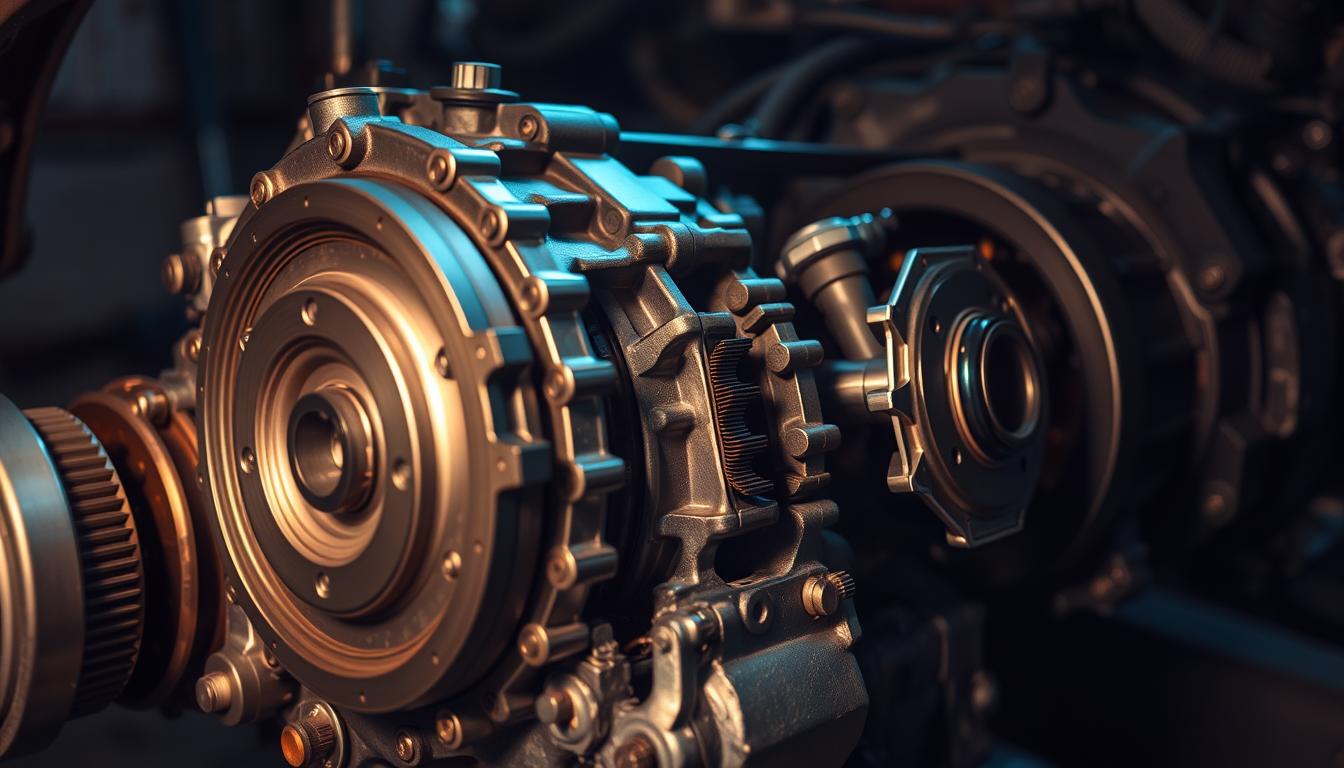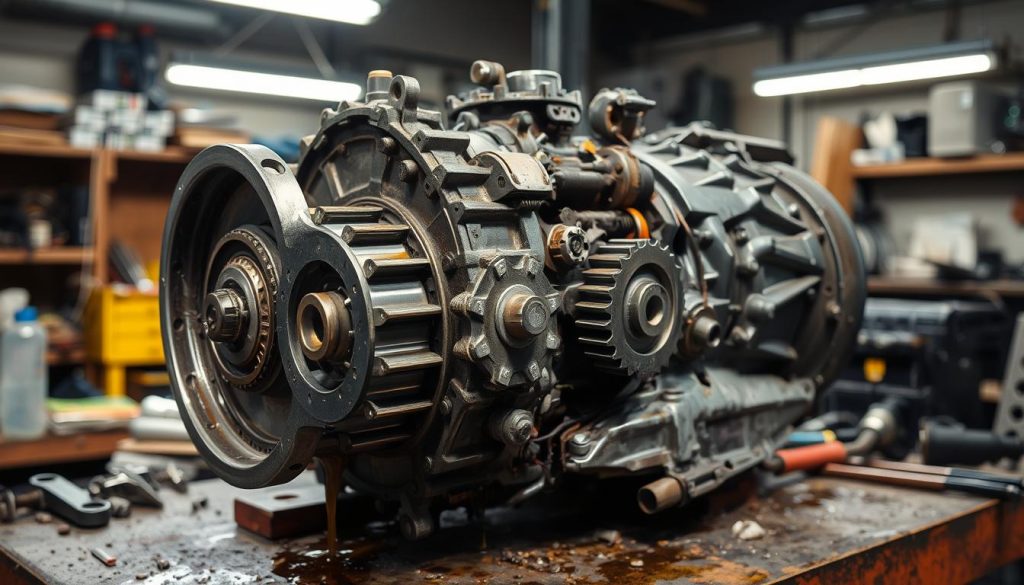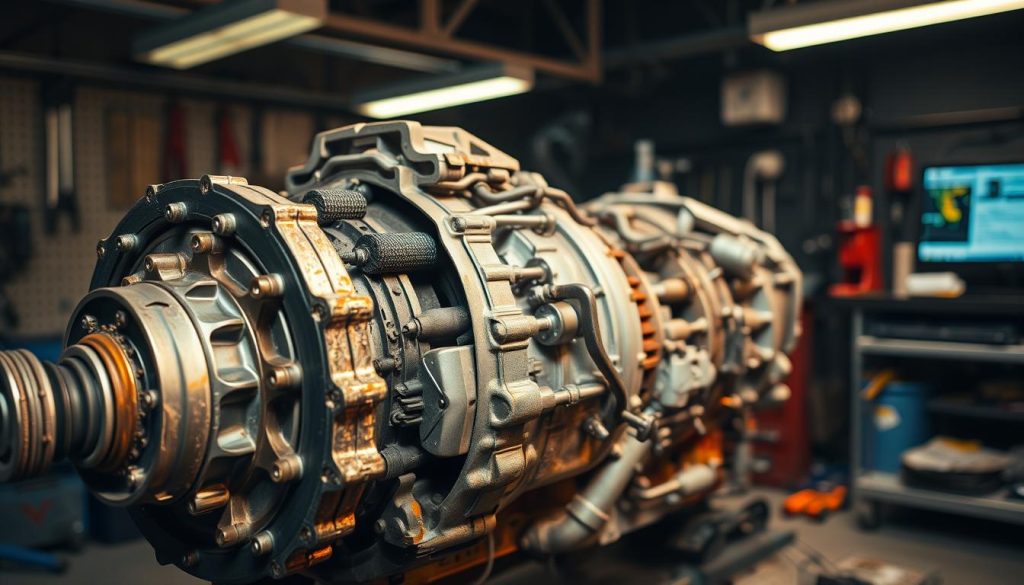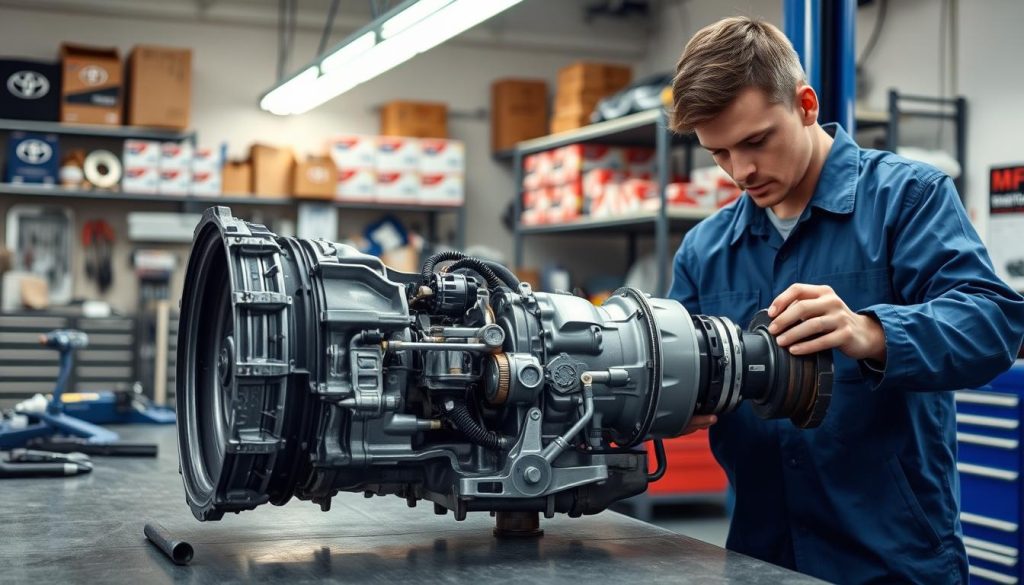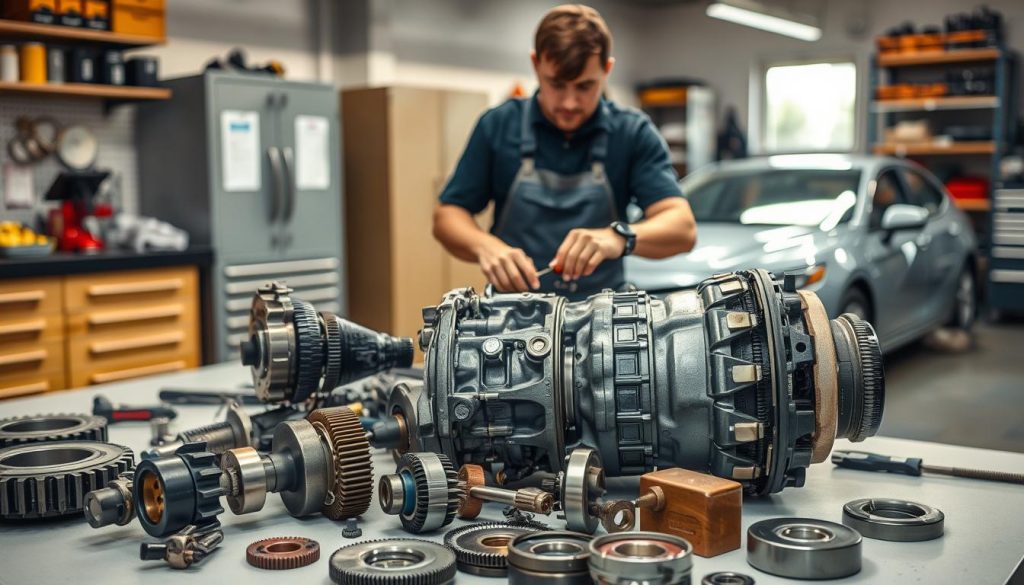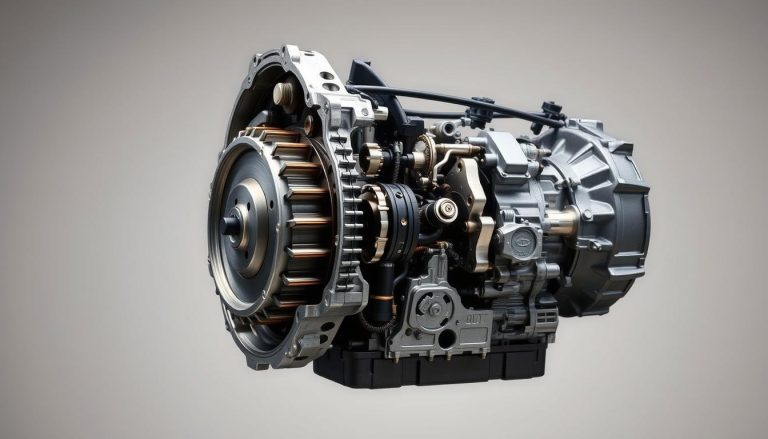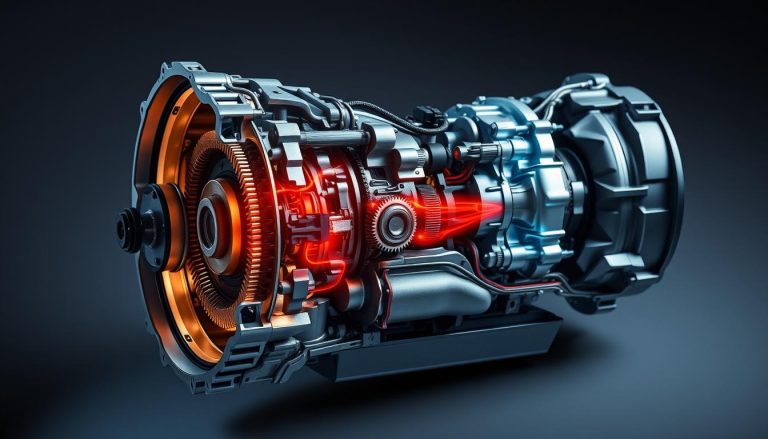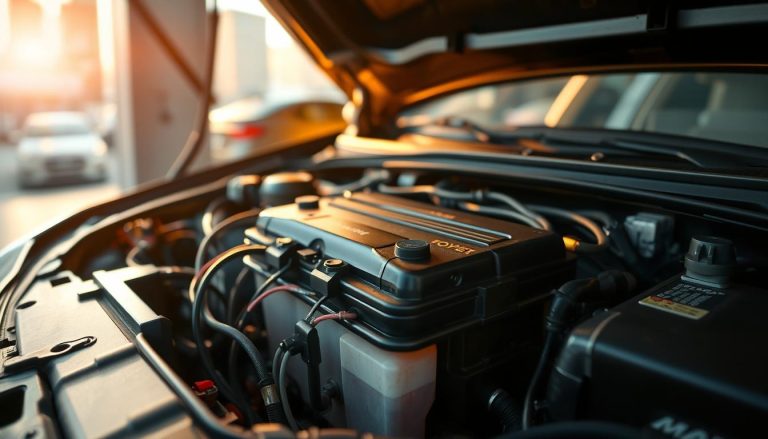Toyota Manual Transmission Issues & Fixes
Toyota’s manual transmissions are famous for their reliability and smooth shifts. Yet, they can face problems like any mechanical part. This article explores common issues and offers fixes for Toyota manual transmission problems.
Knowing about these challenges can help car owners save time and money. This guide is for everyone, whether you’re new to manual transmissions or have some experience. It aims to help you maintain your Toyota’s manual transmission at its best.
Understanding Toyota Manual Transmissions
Toyota manual transmissions give drivers control and quick response. They need regular care to last long and work smoothly. We’ll look at the main parts and how the clutch and gearbox work together. This shows why keeping up with maintenance is key for the best performance.
Basic Components of a Manual Transmission
Toyota manual transmissions have important parts: the clutch, gearbox, driveshaft, and differential. Each part is vital for moving power from the engine to the wheels. Keeping up with maintenance, like checking fluid and the clutch, helps avoid problems and makes the system last longer.
- Clutch: Connects and disconnects the engine and transmission.
- Gearbox: Changes the torque and speed sent to the driveshaft.
- Driveshaft: Carries power from the transmission to the differential.
- Differential: Sends power to the wheels for smooth turns.
The Role of Clutch and Gearbox
The clutch and gearbox work together for a smooth drive in a Toyota manual transmission. The clutch lets drivers change gears without a hitch. The gearbox then matches the engine’s power to the gear chosen. Keeping these parts in good shape, through regular maintenance, helps avoid issues like grinding gears or slipping clutches.
Common Toyota Manual Transmission Problems
Even though Toyota is known for being reliable, their manual transmissions can have issues. This section will cover common problems like broken crossmembers, throwout bearing failure, and trouble shifting gears.
Broken Crossmembers
Broken crossmembers are a big problem. They can cause misalignment and stress on the drivetrain. Located under the car, they support the engine and transmission.
If they break, the car can move too much and vibrate. This affects the car’s stability. It’s important to check them often and replace them when needed to avoid bigger problems.
Throwout Bearing Failure
Throwout bearing failure is another common issue. This part is key for the clutch to work right. If it fails, you might hear a grinding sound or have trouble shifting gears.
Fixing this problem quickly can save you from more expensive repairs later. It also helps keep shifting smooth.
Difficulty Shifting Gears
Shifting gears can be hard for many reasons. It might be because of worn-out synchros, misaligned linkage, or low transmission fluid. You might hear a grinding sound or feel resistance when shifting.
To solve this, check the clutch, gear linkage, and make sure the transmission fluid is good. If the problem doesn’t go away, you might need a professional to fix it.
Troubleshooting Toyota Manual Transmission Issues
Fixing Toyota manual transmission problems starts with understanding the symptoms. Using advanced tools helps spot issues early. This way, you can catch problems before they get worse.
Identifying the Problem Through Symptom Analysis
Spotting Toyota manual transmission issues means looking for specific signs. You might hear odd noises, struggle to shift gears, or smell something burning. These signs often point to wear or failure.
By watching for these signs, you can catch problems early. This makes fixing the issue easier.
Using Diagnostic Tools for Accurate Results
Diagnostic tools are key for a precise check-up of Toyota manual transmissions. They read error codes and show how the transmission is doing in real-time. With these tools, you can find the exact cause of any trouble.
These tools are super helpful for both mechanics and car owners. They help fix Toyota transmission problems and keep your car running smoothly.
Signs of Toyota Transmission Failure
If you’re driving a Toyota and notice signs of transmission issues, it’s important to pay attention. Knowing these signs can help you fix Toyota transmission problems early on.
Sticking Clutch Pedal
A sticking clutch pedal is a clear sign of Toyota transmission issues. If the pedal doesn’t move back smoothly or gets stuck, it might mean a problem. This could be due to worn-out clutch parts or a hydraulic issue.
Squeaking Clutch Pedal
A squeaking clutch pedal is another common sign of Toyota manual transmission problems. This noise usually comes from not enough lubrication or a failing clutch release bearing. Keeping up with maintenance and lubrication can stop further damage.
Clunking When Shifting
Clunking noises when shifting gears are a sign of Toyota transmission issues that need attention. These sounds often come from worn-out gear synchronizers or other internal parts. If ignored, they can cause more serious damage and expensive repairs.
How to Fix Toyota Manual Transmission Issues
Learning how to fix Toyota manual transmission problems can make your car last longer and drive better. This guide will walk you through how to find and fix common issues.
Step-by-Step Repair Procedures
- Diagnose the Issue: Start by noticing any odd sounds, hard gear shifts, or a slipping clutch. Knowing what’s wrong helps you find the right fix.
- Gather Tools and Materials: Make sure you have the right tools like a wrench set, screwdrivers, pliers, and a Toyota service manual.
- Inspect the Clutch and Transmission: Take off the transmission cover to look for wear or damage on the clutch, gears, or bearings.
- Replace Faulty Components: If you see damaged parts, like a bad clutch plate or bearings, use your service manual to replace them.
- Reassemble and Test: After fixing things, put the transmission back together. Make sure it’s all secure. Then, test drive the car to see if the problem is fixed.
Choosing the Right Tools
Having good tools is key to fixing Toyota manual transmission problems. Here are some important tools you’ll need:
- Torque Wrench: It makes sure bolts are tightened right.
- Transmission Jack: It helps safely take out and put back the transmission.
- Clutch Alignment Tool: It helps get the clutch in the right spot during installation.
- Slide Hammer: It’s good for taking out bearings and other stuck parts.
- Service Manual: It has all the specific instructions for your Toyota.
With these steps and the right tools, you can fix most Toyota manual transmission problems with confidence. Always check your service manual for exact instructions for your car.
Best Solutions for Toyota Manual Transmission Problems
When dealing with Toyota manual transmission issues, two main solutions can help a lot. These are replacing worn out parts and adjusting the hydraulic clutch. Both methods are great for fixing common problems.
Replacing Worn Out Components
Replacing worn out parts is a top solution for Toyota manual transmission issues. It’s important to check and replace parts like the clutch and gearbox regularly. These parts help your transmission work smoothly.
Replacing them can fix problems like hard shifting and strange noises.
Hydraulic Clutch Adjustments
Adjusting the hydraulic clutch is another key solution. A bad clutch adjustment can cause shifting troubles and a stuck pedal. Making sure the clutch is adjusted right improves your car’s performance and makes it last longer.
Importance of Regular Transmission Maintenance
Keeping your Toyota manual transmission in good shape is key for your car’s performance and avoiding problems. Knowing how to maintain your transmission can save you money and make it last longer. It’s all about following the right maintenance tips.
Routine Fluid Changes
Regular fluid changes are a must for your Toyota manual transmission. The fluid keeps things running smoothly and cool. It’s important to change the fluid as recommended to avoid overheating and wear.
Sticking to Toyota’s service schedule for fluid changes is a smart move. It helps prevent common issues with your transmission.
Checking and Adjusting Clutch Settings
It’s also vital to check and adjust your clutch settings often. The clutch is essential for smooth shifting and controlling power. If it’s not set right, you might face shifting problems or wear out your transmission faster.
By keeping an eye on and adjusting your clutch, you ensure your car runs smoothly. This is a critical part of taking care of your transmission.
Toyota Tacoma Transmission Issues
The Toyota Tacoma has faced many transmission problems over the years. These issues affect how well the vehicle drives and performs. We will look at some of the most common problems.
Known Problems with Tacoma Models
Toyota Tacoma models from the mid-2000s to early 2010s have had many transmission issues. These include:
- Premature clutch wear and tear
- Difficulty in shifting gears
- Synchronization issues between gears
These problems often come from manufacturing defects or design flaws. Many owners have had to take their cars to mechanics often. This can lead to high repair costs.
User Experiences and Reviews
Online forums and reviews show what Toyota Tacoma owners go through. They often talk about grinding noises and clutch problems. Here are some examples:
- “My Tacoma started having clutch issues at 30,000 miles. It’s been a big problem ever after.”
- “Shifting gears is hard, even in cold weather. It’s hard to drive smoothly.”
- “Even after many repairs, my transmission doesn’t work right. Many Tacoma owners face this issue.”
These stories show how serious and common the transmission problems are. They highlight the need for better maintenance and manufacturing by Toyota.
Diagnosing Problems with Onboard Computers
Modern Toyota vehicles have complex onboard computers. These computers are key in finding and fixing Toyota transmission problems. Specialized tools are needed to talk to these systems and find the exact issue.
Knowing how to use these tools is very important. They connect with your car’s computer to get error codes and data. This info helps fix any transmission problems quickly and correctly.
Thanks to technology, Toyota makes it easy to find and fix manual transmission issues. This makes repairs faster and keeps your Toyota running smoothly.
Manual vs Automatic Toyota Transmissions
Choosing between manual and automatic transmissions for your Toyota is important. Each has its own benefits and drawbacks. Knowing these can help you pick the best one for your driving style.
Advantages and Disadvantages
Manual transmissions are loved by driving fans for their control and feel. But, they can have issues like worn-out clutches. Automatics make driving easy, but they can have problems like sensor failures.
Reliability and Maintenance Differences
Manual and automatic transmissions have different reliability and maintenance needs. Manuals are simpler and cheaper to fix, but repairs can be hard. Automatics are smoother but have more complex parts, leading to higher repair costs.
| Aspect | Manual Transmission | Automatic Transmission |
|---|---|---|
| Driving Experience | More engaging, better control | Smoother, easier in traffic |
| Common Problems | Clutch wear, shift issues | Sensor failures, fluid leaks |
| Maintenance | Less frequent but can be labor-intensive | More frequent, can be costly |
Understanding the differences between manual and automatic transmissions is key. Each has its own strengths and weaknesses. So, think about your driving habits and what matters most to you before making a choice.
Common Causes of Transmission Problems
Knowing why transmissions go wrong is key for Toyota owners. Many issues come from normal wear and tear, or not keeping up with maintenance. Shifting gears a lot and using the car a lot can wear down parts.
Not having enough or the right type of transmission fluid is another big problem. This fluid keeps things cool and moving smoothly. If you don’t change it often enough, parts can get damaged.
Not checking and fixing things regularly can make problems worse. It’s important to check and adjust the clutch settings often. Also, worn-out parts like the clutch disc and flywheel can hurt how well the transmission works.
Driving habits and where you drive can also cause problems. Driving hard, stopping and starting a lot, and driving on rough roads can wear down parts faster. This can make the transmission fail sooner than it should.
To avoid transmission issues, stick to the recommended maintenance schedule. Change the fluid regularly and fix any problems right away. Replacing worn-out parts quickly can keep your transmission running smoothly.
How Mister Transmission Can Help
Mister Transmission is a top choice for Toyota transmission repair and service. They are known for their wide range of services. This ensures your car gets the best care possible.
Expert Services Provided
Mister Transmission offers many services for your Toyota’s manual transmission. These include:
- Complete diagnostic evaluations to find transmission problems.
- Comprehensive Toyota transmission repair, including clutch and gearbox replacements.
- Routine Toyota manual transmission service for top performance and longevity.
- Hydraulic clutch adjustments and maintenance.
Customer Reviews and Testimonials
Customers love the service at Mister Transmission. Here are some testimonials that show their skill:
| Customer | Review |
|---|---|
| Jennifer L. | “The Toyota transmission repair service was thorough and professional. My car runs smoother than ever!” |
| Marcus R. | “Their Toyota manual transmission service was outstanding. The team was knowledgeable and addressed all my concerns.” |
| Christine B. | “I highly recommend Mister Transmission for any Toyota transmission repair needs. They are the best in the business!” |
Choosing Mister Transmission means you get top-notch service. You’ll know your car is in good hands.
The Role of Clutch Pedal Behavior in Diagnosing Problems
Knowing how the clutch pedal acts is key to finding manual transmission problems. By watching how the pedal moves, you can catch issues early. This can save you from expensive fixes later. This guide will show you how to spot Toyota transmission failure signs and fix Toyota manual transmission issues.
Observing Pedal Response in Different Conditions
The clutch pedal’s behavior changes with driving conditions. To diagnose problems, watch the pedal in different situations:
- Starting the Car: A sticky or unresponsive pedal when starting might mean hydraulic or linkage issues.
- Changing Gears at Different Speeds: Trouble shifting gears or feeling resistance could mean worn parts or misalignment.
- Engaging the Clutch in Traffic: Using the clutch a lot in traffic can show binding or hesitation problems.
Impact of Temperature on Clutch Performance
Temperature affects your Toyota’s clutch. Cold weather makes it stiff, while heat causes slippage and wear. Watching these changes helps spot failures and fix Toyota manual transmission problems. Key things to notice include:
- Cold Mornings: A stiff clutch pedal might mean thick fluid or linkage issues.
- Hot Conditions: Heat can make the pedal soft, showing fluid problems or clutch wear.
| Condition | Symptom | Possible Issue |
|---|---|---|
| Cold Start | Stiff Clutch | Thickened Fluid or Binding Linkage |
| Hot Weather | Soft Pedal | Fluid Contamination, Clutch Fade |
| Heavy Traffic | Binding, Hesitation | Worn Components or Misalignment |
By paying attention to these signs, you can catch Toyota transmission failure early. Fixing Toyota manual transmission problems is easier with the right knowledge. This way, you can keep your car running well and reliably.
DIY Repair Tips for Toyota Manual Transmissions
Want to fix your Toyota manual transmission yourself? Knowing the basics can be very empowering. With the right tools and knowledge, you can handle common problems on your own.
Basic Tools Required
Before starting your DIY repair, make sure you have these tools:
- Socket set
- Torque wrench
- Screwdrivers (Phillips and flat-head)
- Drain pan
- Jack and jack stands
- Flywheel locking tool
- Transmission fluid pump
Common DIY Fixes
Fixing minor issues yourself can save you money and time. Here are some common repairs you can do:
- Replacing Worn Clutch Parts: If shifting gears is hard or the clutch pedal sticks, check and replace worn parts.
- Adjusting Clutch Cable: Clutch cables can stretch over time, causing problems. Adjusting or replacing it can fix this.
- Changing Transmission Fluid: Regular fluid changes are key. Use the right fluid and keep levels right for better performance.
- Fixing Leaks: Look for leaks in the transmission casing and parts. Tightening bolts and replacing gaskets can fix leaks.
By using these DIY tips, you’ll learn how to fix Toyota manual transmission problems. You’ll also feel more confident in doing repairs yourself.
Professional Repair vs. DIY: Which is Better?
Choosing between professional repair and DIY for Toyota transmission issues is tough. We’ll look at costs, expertise, and equipment to guide you.
Cost Considerations
Cost is key when fixing Toyota manual transmissions. DIY can save on labor but parts and tools can be pricey. Professional repairs might cost more but offer warranties and peace of mind.
Expertise and Equipment Differences
Pros have the skills and tools for efficient repairs. They’re great for complex problems. DIY needs mechanical knowledge and the right tools, which can be hard for newbies.
It’s all about your skills, tools, and whether you want professional help.
Preventative Measures to Avoid Transmission Problems
Keeping your Toyota’s manual transmission in top shape is key. Regular care can make your transmission last longer and reduce problem risks. Here are some tips to keep your car running smoothly.
First, stick to a regular maintenance plan. Follow these Toyota manual transmission maintenance tips to keep your car in great shape:
- Regularly check and change the transmission fluid to keep it well-lubricated and prevent wear.
- Look for signs of wear in the clutch system and replace parts when needed.
- Listen for odd noises or trouble shifting gears, which might mean there’s a problem.
- Check the transmission for leaks and fix them quickly to keep the fluid levels right.
Getting your car checked by a certified mechanic is also vital in preventing Toyota transmission issues. Regular visits can spot problems early, so they can be fixed quickly.
| Maintenance Tips | Benefits |
|---|---|
| Regular Fluid Changes | Ensures proper lubrication and prevents overheating |
| Clutch Inspections | Detects wear early, preventing sudden failures |
| Leak Checks | Maintains optimal fluid levels |
| Professional Diagnoses | Catches issues early with expert analysis |
Conclusion
Knowing about Toyota manual transmission problems is key for car owners who want their vehicles to last long. This article covered the basics of manual transmissions and common issues like broken crossmembers and throwout bearing failures. It also talked about how to spot these problems early and fix them.
It’s important to know how to fix Toyota transmission problems. This includes replacing worn-out parts and adjusting the hydraulic clutch. Regular maintenance, like fluid changes and clutch adjustments, can also help. This can prevent sudden breakdowns and improve your Toyota’s performance.
It’s all about making smart choices between professional repairs and DIY fixes. Knowing how to maintain your vehicle and fix problems quickly is essential. Keeping up with your Toyota’s transmission health is vital for safe and efficient driving.
FAQ
What are the basic components of a Toyota manual transmission?
A Toyota manual transmission has several key parts. These include the clutch, gearbox, driveshaft, and gears. They work together to move power from the engine to the wheels. This lets you change gears smoothly.
What roles do the clutch and gearbox play in Toyota manual transmissions?
The clutch connects and disconnects the engine from the transmission. This makes it possible to change gears. The gearbox has different gears for various speeds and torque. This helps drive smoothly at different speeds.
What are some common Toyota manual transmission problems?
Issues like broken crossmembers and throwout bearing failure are common. Shifting gears can also be hard. These problems affect how well the car drives.
How can I troubleshoot Toyota manual transmission issues?
Start by noticing any odd noises or shifting problems. Use diagnostic tools to find the exact issue. These tools connect with the car’s computer to pinpoint problems.
What are the signs of Toyota transmission failure?
Look out for a sticking or squeaking clutch pedal. Also, listen for clunking noises when shifting. Trouble getting into gear is another sign. These symptoms mean you need to fix the problem fast.
How can I fix Toyota manual transmission issues?
Fixing problems might mean replacing worn parts or adjusting the clutch. Using the right tools is key for a good repair.
What are the best solutions for Toyota manual transmission problems?
The best fix is to replace old parts and adjust the clutch. This ensures your car runs well.
Why is regular transmission maintenance important?
Regular care, like fluid changes and clutch checks, prevents issues. It keeps your transmission running smoothly for a long time.
What transmission issues are common in Toyota Tacoma models?
Tacomas often have trouble shifting gears and wear out clutches fast. Many owners share their experiences of these problems.
How are onboard computers used in diagnosing transmission problems?
Modern Toyotas have onboard computers that store codes. Special tools can read these codes. This makes finding transmission problems easier.
How do manual and automatic Toyota transmissions compare?
Manual transmissions offer a fun drive and are easier to maintain. Automatics are more convenient but need more maintenance. Choose based on your driving style.
What are common causes of Toyota transmission problems?
Problems often come from wear and tear, not enough maintenance, or faulty parts. Taking good care of your car can prevent these issues.
How can Mister Transmission help with Toyota manual transmission repairs?
Mister Transmission provides expert diagnosis and repair for Toyota manuals. Their quality and customer service are well-reviewed.
How does clutch pedal behavior help diagnose transmission problems?
Watching how the clutch pedal acts can show problems. A sticky or squeaky pedal might mean clutch or hydraulic issues. Clutch performance can also change with temperature.
What are some DIY repair tips for Toyota manual transmissions?
For simple fixes, use basic tools like wrenches and screwdrivers. This lets you handle small repairs yourself.
Should I choose professional repair or DIY for my Toyota manual transmission?
It depends on your skills, tools, and budget. Pros offer expertise and tools, while DIY can save money. Think about what’s best for you.
What are preventative measures to avoid Toyota transmission problems?
Regular maintenance, like fluid changes and clutch checks, helps. Also, routine inspections catch problems early. These steps keep your transmission in top shape.

